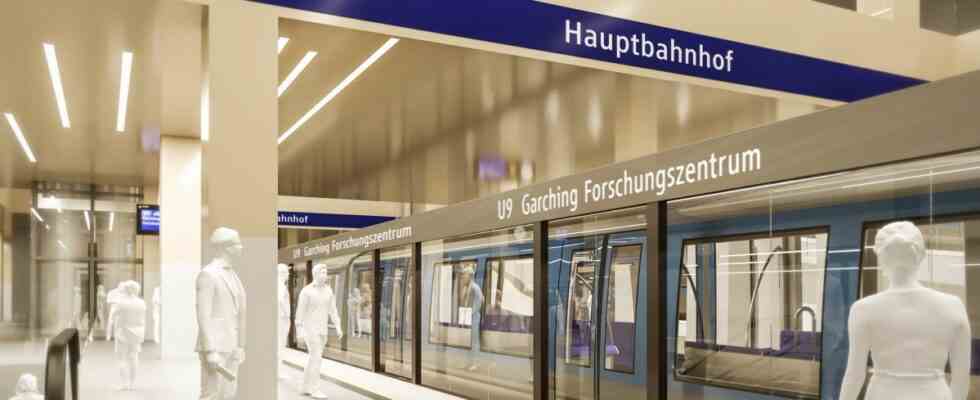Recently it looked as if the planned new subway line U9 could fail due to the high costs. There was talk of four billion euros in construction costs. And just the shell of the subway station at the main train station could cost around 560 million euros – or even more. But now there is a broad majority in the city council for the U9, even at the risk that there will be no funding. Because the Federal Ministry of Transport has still not officially committed to financing.
The support structure for a future subway station is part of the already approved plans for the new construction of the main station, which is being built as part of the second S-Bahn trunk line. So that the railway does not have to reschedule again and this causes further delays, the city council would at least have to decide on the shell. The politicians’ dilemma is that if the city couldn’t afford the immense expenses for the entire subway system due to a lack of funding, it would have invested the money for the construction of the subway for nothing.
But the railway insists on a quick decision. And it looks like the U9 is already on the agenda for the next general meeting of the city council next Wednesday. The SPD signals approval: “The U9 is an important relief route for our Munich subway network, which we urgently need for sustainable local public transport,” says parliamentary group leader Christian Müller. “But we’ll only get this chance if we now decide on the holding structure at the main train station.” One goes here in advance, also because the construction of the second main S-Bahn line, which is just as urgently needed, should not be delayed any further. “At the same time, however, we are finally expecting reliable funding commitments from the federal and state governments.”
The Greens want to finally discuss their decision on Monday. Group leader Mona Fuchs is already declaring that they want to massively advance the Munich subway construction during this term of office. “The U9 is an absolutely necessary, sensible building block to relieve the public transport hub around Munich Central Station,” she says. But the federal government must now finally show its colors. It cannot be that the Federal Ministry of Transport leaves a municipality in the dark for so long and exposes it to the risk of being left with the costs.
The Free State signals a “cautious concession”
The CSU wants to approve the project in any case, even if the city councilors did not have a draft resolution on Thursday. “If we don’t do that, the U9 will be dead,” says parliamentary group leader Manuel Pretzl. You still stand behind it, even with the increased costs. You have to accept this. “We don’t pay everything at once,” says Pretzl. Calculated over the individual years, he estimates that the city would incur around 70 to 80 million euros per year. “You can handle that.”
Mayor Dieter Reiter (SPD) is also clearly committed to the new line: “Basically, the decision to build a detention facility is a key milestone for future mobility in Munich,” he says. Without the connection of a subway line to the main train station, a relief for the already very busy public transport network is unthinkable. “That’s why, despite existing uncertainties about the financing, I am taking the risk. Unfortunately, the Federal Minister of Transport has not made any clear statements about future financing, despite repeated inquiries.” However, at least the Free State of Bavaria has signaled a “cautious concession” in a letter recently received.
The U9 would replace the current U6 line, connecting Sendling and Schwabing over a distance of 10.5 kilometers, with six stations between Implerstraße and Münchner Freiheit. A total of five new underground stations would be created, and the stop at the main train station would offer a transfer option to the second S-Bahn trunk line. From there, another branch towards Theresienstraße could arise, whereby the Munich transport company (MVG) could offer a possible relief line U29 for the U2. This would then connect the Großhadern Clinic with the Harthof.
The Theresienstraße station would have to be expanded to include a track. East of the Theresienwiese, at Esperantoplatz, Munich would have a second Oktoberfest underground station. There are also plans to merge the existing Implerstrasse and Poccistrasse stations and to replace them with a new building. This in turn would be a transfer point to the planned Poccistraße regional train stop: a new, efficient transport hub would be created south of the city centre.
In Schwabing, a new underground station is to be built at the Pinakotheken and one at Elisabethplatz. North of the Münchner Freiheit, the train would merge back onto the U6 route, for which a new transfer station would have to be built. The MVG is assuming a construction period of around ten years. The U9 could start operating in the early 2040s. The U3 would then no longer have to share the route running between Implerstraße and Münchner Freiheit with the U6, which would make frequency increases possible. However, passengers would have to adjust to new connections – but then probably in less crowded and more punctual trains.

